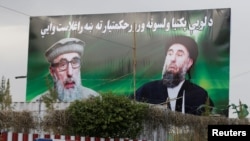An intensifying political rivalry between two leading Afghan Islamist movements now poses a threat to the country’s political stability and might undermine U.S. President Donald Trump’s strategy for Afghanistan.
Frequent mutual accusations and taunts by top leaders are now reviving clashes between the predominantly Pashtun Hizb-e Islami and Jamiat-e Islami, mainly followed by ethnic Tajiks.
After decades of infighting and power plays, their competition is taking center stage as Afghanistan struggles with mounting violence by the Taliban and other insurgent groups.
Atta Mohammad Noor, the powerful governor of Balkh and chief executive of Jamiat-e Islami, hyped the tensions between the two parties after accusing Hizb-e Islami leader Gulbuddin Hekmatyar of supporting the Islamic State (IS) militants’ violent campaign in Afghanistan.
“He [Hekmatyar] had pledged allegiance to Daesh (eds: local name of IS) and has not renounced the allegiance,” Noor told supporters on September 1. “This person [Hekmatyar] is involved in all these attacks and violence carried out in the name of Daesh.”
The accusation followed Atta’s attempt to shame the Hizb-e Islami leader for making peace with the Afghan government after leading his faction in an insurgency for nearly 15 years.
“You [Hekmatyar], who is known as the Butcher of Kabul, with what face did you come to Kabul?” Noor recently told supporters in a scathing attack on Hekmatyar’s return to the Afghan capital in May. “You had vowed to never return even if there was one American soldier in Afghanistan, with which face [what dignity] did you come to Kabul?”
Hekmatyar, however, rejects such accusations. Without naming Noor or his allies, he recently accused them of fomenting instability and said they are benefiting from the ongoing war in Afghanistan.
“I didn’t tell them to go to Ankara to form an anti-government alliance to threaten and undermine the current administration,” he told the BBC’s Pashto Service in a recent interview.
In Ankara two months ago, Atta and other Jamiat-e Islami leaders joined exiled Afghan Vice President Abdul Rashid Dostum’s predominantly Uzbek Junbish-e Milli Islami Afghanistan and the predominantly Hazara People’s Islamic Unity Party of Afghanistan to form a new political alliance.
Since his return to the Afghan political stage, Hekmatyar has offered scathing public criticism of Jamiat-e Islami’s prominence in the current power-sharing arrangement.
“Six-hundred generals in the Defense Ministry are from Panjshir because the defense minister was from Panjshir,” he said last month, citing an example of Jamiat-e Islami’s dominance in government institutions.
“In the whole of Europe, you won’t find 600 generals. But in Afghanistan, there are 600 generals from just one district,” he added, referring to Panjshir’s status as an isolated mountainous district. Now a province and home to key leaders of Jamiat-e Islami, Panjshir has turned into a key bastion of power in the country after the demise of the Taliban regime in late 2001.
The growing rift between the two parties comes at a time when Kabul is struggling to ward off insurgent battlefield advances and attacks in the cities, widespread corruption, and economic decline.
It also poses new challenges to Trump’s new strategy, which counts on government reforms and political stability to continue supporting Kabul.
Wadir Safi, a political science professor at Kabul University, says the rift could undermine Trump’s strategy, which has now prioritized longstanding Afghan calls for an end to insurgent sanctuaries in neighboring Pakistan.
"This verbal warfare would destroy Trump’s strategy without Pakistan or anyone else acting to undermine it,” he said.
Safi says members of the two parties make up a large part of the Afghan government work force, particularly in the military, intelligence, and police.
“When their leaders are publicly sparring, the soldiers will no longer fight,” he noted. “They would sell their guns and their tanks to the enemy.”
Afghans have vivid memories of the destruction and suffering they endured because of clashes between the two in recent decades. They occasionally clashed during the anti-Soviet war in the 1980s. But after the demise of the Afghan communist regime in 1992, tens of thousands of supporters and civilians were killed by their infighting.








